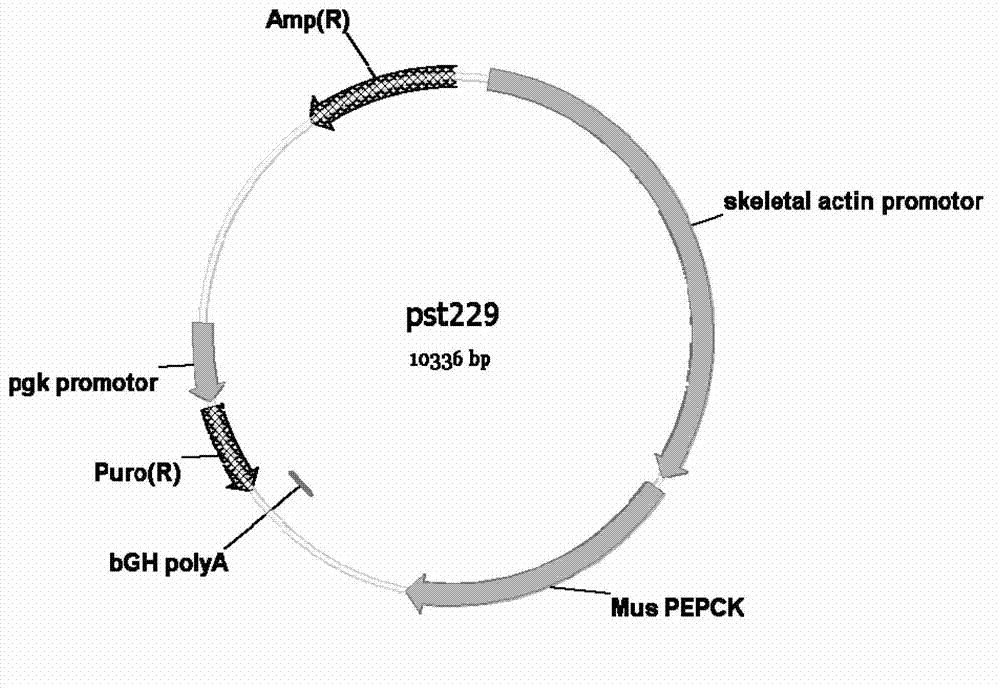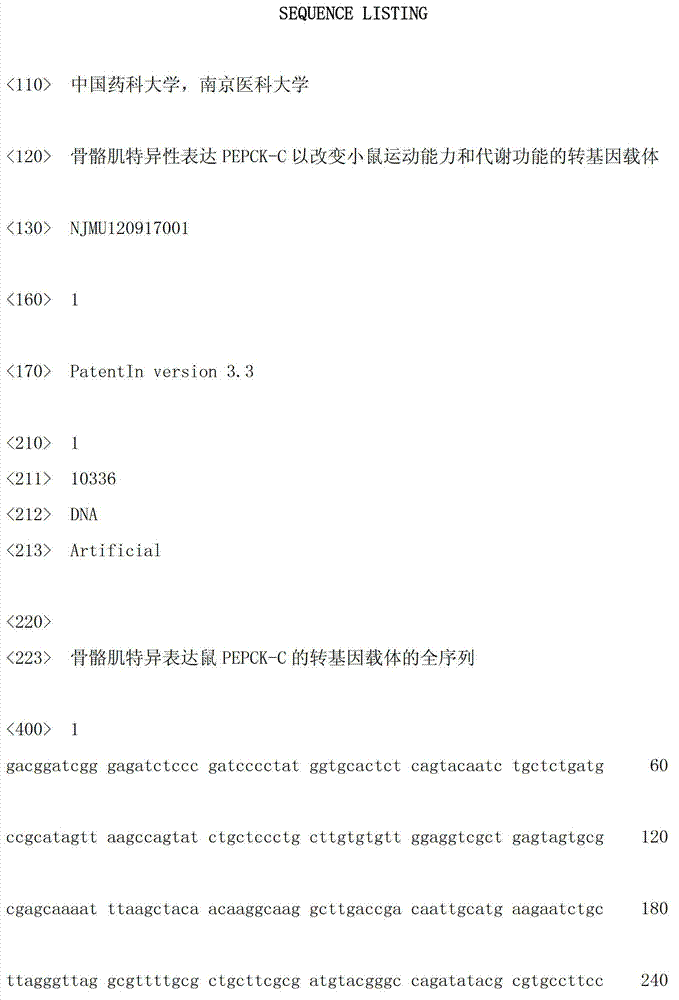Transgene carrier for changing mouse movement ability and metabolic function by specific expression of PEPCK-C (phosphoenolpyruvate carboxykinase-cytosolic) in skeletal muscle
A transgenic carrier and skeletal muscle-specific technology, applied in the field of genetic engineering, can solve problems such as unclear metabolism
- Summary
- Abstract
- Description
- Claims
- Application Information
AI Technical Summary
Problems solved by technology
Method used
Image
Examples
Embodiment 1
[0014] Example 1: Inserting a DNA fragment of the mouse PEPCK-C coding region to construct pst228.
[0015] The vector pst215 in our laboratory was double-digested with BsaBI and AscI. The enzyme digestion system was 2 μg plasmid DNA, 3 μl 10× buffer, 1.5 μl BsaBI enzyme, 1.5 μl AscI enzyme, and ddH 2 O to make up the volume to 30 μl and incubate at 37°C for 3 hours. Then the digestion system was separated by electrophoresis in 1% agarose gel, and the 6.3kb DNA band was cut out, and the DNA was purified with a gel recovery purification kit. The specific steps are as follows: put the target DNA band excised under ultraviolet light into a 1.5ml centrifuge tube, add 3 times the volume of sol solution after weighing, and incubate at 55°C for 10 minutes to completely melt the agarose gel; After the temperature has dropped to room temperature, transfer the mixture to the attached column, centrifuge at 10,000g for 1 minute, and discard the effluent; add 650 μl of washing buffer, cen...
Embodiment 2
[0020] Example 2: Insert the promoter DNA fragment of mouse α-skeletal muscle actin gene to construct pst229.
[0021] Digest pst228 with Nrul and BsaBI, the enzyme digestion system is 2 μg plasmid DNA, 3 μl 10× buffer, 1.5 μl Nrul enzyme, 1.5 μl BsaBI enzyme, add ddH 2 O to make up the volume to 30 μl and incubate at 37°C for 3 hours. Then the digestion system was separated by electrophoresis in 1% agarose gel, and the DNA band with a size of 7.0 kb was cut out, and the DNA was purified with a gel recovery and purification kit. The specific steps are the same as above.
[0022] The promoter DNA fragment of the mouse α-skeletal muscle actin gene of 3.3 kb was obtained by PCR amplification, and the PCR conditions were as follows: 1 μ l (about 100 ng) mouse genomic DNA, primer 1 (TCG CGA ACG CGT GCCTTCCCTGTC) and primer 2 ( The final concentration of GAT CAC GAT CTA GTT TCT GCA AAG ACA AG) is 0.5 μM, the final concentration of dNTPs is 0.2 mM, 5 μl 10× buffer, 1 μl HiFi Taq en...
Embodiment 3
[0028] Example 3: Construction and identification of transgenic mice using the method of pronuclear injection.
[0029] The constructed pst229 transgenic vector was directly injected into the fertilized eggs to integrate the foreign gene into the DNA, and then the fertilized eggs were implanted into surrogate mother mice aged 4-5 weeks.
[0030] PEPCK-C mus After the transgenic mice were successfully bred, related studies on exercise and metabolism were carried out. The study found that compared with wild-type mice of the same age, PEPCK-C mus The transgenic mice had stronger exercise ability (mouse exercise treadmill test 158.25±54.59vs.2366±687.77, unit: m, P<0.01), and higher insulin sensitivity (area under the blood glucose-time curve of insulin tolerance test 16.27±1.16vs .15.19±0.90, unit: mmol / L, P<0.05), lower blood lipid level (1.64±0.20vs.5.19±2.02, unit: nmol / L, P<0.01), fasting blood glucose (7.73±0.35vs.6.48 ±0.78, unit: mmol / L), body weight (25.95±0.07vs.28.25±...
PUM
 Login to View More
Login to View More Abstract
Description
Claims
Application Information
 Login to View More
Login to View More - R&D
- Intellectual Property
- Life Sciences
- Materials
- Tech Scout
- Unparalleled Data Quality
- Higher Quality Content
- 60% Fewer Hallucinations
Browse by: Latest US Patents, China's latest patents, Technical Efficacy Thesaurus, Application Domain, Technology Topic, Popular Technical Reports.
© 2025 PatSnap. All rights reserved.Legal|Privacy policy|Modern Slavery Act Transparency Statement|Sitemap|About US| Contact US: help@patsnap.com



